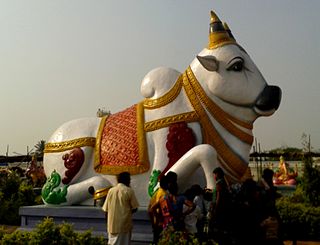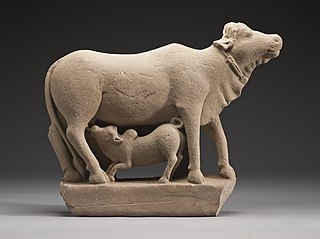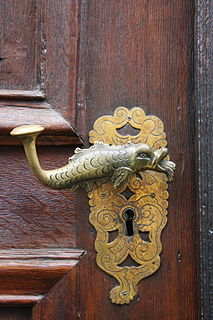 W
WAnimal worship is rituals involving animals, such as the glorification of animal deities or animal sacrifice. When a god is respected or worshipped by means of a representative animal, an animal cult is formed. Animal cults may be classified according to their outward form or according to their inward meaning, which may of course undergo transformations.
 W
WBear worship is the religious practice of the worshipping of bears found in many North Eurasian ethnic religions such as the Sami, Nivkh, Ainu, Basques, Germanics, Slavs and Finns. There are also a number of deities from Celtic Gaul and Britain associated with the bear, and the Dacians, Thracians, and Getians were noted to worship bears and annually celebrate the bear dance festival. The bear is featured on many totems throughout northern cultures that carve them.
 W
WThere are varying beliefs about cattle in societies and religions with cows, bulls, and calves being worshiped at various stages of history. As such, numerous peoples throughout the world have at one point in time honored bulls as sacred. In the Sumerian religion, Marduk is the "bull of Utu". In Hinduism, Shiva's steed is Nandi, the Bull. The sacred bull survives in the constellation Taurus. The bull, whether lunar as in Mesopotamia or solar as in India, is the subject of various other cultural and religious incarnations as well as modern mentions in New Age cultures.
 W
WDue to the multiple benefits from cattle, there are varying beliefs about cattle in societies and religions. In some regions, especially most states of India, the slaughter of cattle is prohibited and their meat may be taboo.
 W
WElephants have been depicted in mythology, symbolism and popular culture. They are both revered in religion and respected for their prowess in war. They also have negative connotations such as being a symbol for an unnecessary burden. Ever since the Stone Age, when elephants were represented by ancient petroglyphs and cave art, they have been portrayed in various forms of art, including pictures, sculptures, music, film, and even architecture.
 W
WHorse worship is a spiritual practice with archaeological evidence of its existence during the Iron Age and, in some places, as far back as the Bronze Age. The horse was seen as divine, as a sacred animal associated with a particular deity, or as a totem animal impersonating the king or warrior. Horse cults and horse sacrifice were originally a feature of Eurasian nomad cultures. While horse worship has been almost exclusively associated with Indo-European culture, by the Early Middle Ages it was also adopted by Turkic peoples.
 W
WHybrid beasts are creatures composed of parts from different animals, appearing in the folklore of a variety of cultures as legendary creatures.
 W
WCultural depictions of lions are known in countries of Afro-Eurasia. The lion has been an important symbol to humans for tens of thousands of years. The earliest graphic representations feature lions as organized hunters with great strength, strategies, and skills. In later depictions of human cultural ceremonies, lions were often used symbolically and may have played significant roles in magic, as deities or close association with deities, and served as intermediaries and clan identities.
 W
WOnolatry is the supposed worship of the donkey. In Imperial Rome, the charge of onolatry was used by the pagans to taunt the Jews and first Christians. The association of Jews with donkeys was a common feature of Hellenic as well as Latin ethnographic and historical writings, and included accusations of worshipping a golden donkey head and even sacrificing foreigners to it at intervals. A famous example of this is the Alexamenos graffito.
 W
WPola is a thanksgiving festival celebrated by farmers in Maharashtra and Chhattisgarh, to acknowledge the importance of bulls and oxen, who are a crucial part of agriculture and farming activities. It falls on the day of the Pithori Amavasya in the month of Shraavana. During Pola, farmers don't work their bulls in the farmland, and the day is a school holiday in the rural parts of Maharashtra.
 W
WLe Regourdou is an archaeological site in the Dordogne department, France, on top of a hill just 800 m (2,600 ft) from the famous cave complex of Lascaux. At this now collapsed 35 m (115 ft) deep ancient karst cavity remarkably well preserved Neanderthal fossils were recovered, that might be skeletal remains of deliberate burials. According to the current excavation team at the site, the correct name of the location is "Regourdou". "Le Régourdou" is considered a misnomer and should be avoided.
 W
WWhite horses have a special significance in the mythologies of cultures around the world. They are often associated with the sun chariot, with warrior-heroes, with fertility, or with an end-of-time saviour, but other interpretations exist as well. Both truly white horses and the more common grey horses, with completely white hair coats, were identified as "white" by various religious and cultural traditions.
 W
WThe word zoomorphism derives from the Greek ζωον (zōon), meaning "animal", and μορφη (morphē), meaning "shape" or "form". In the context of art, zoomorphism could describe art that imagines humans as non-human animals. It can also be defined as art that portrays one species of animal like another species of animal or art that uses animals as a visual motif, sometimes referred to as "animal style." In ancient Egyptian religion, deities were depicted in animal form which is an example of zoomorphism in not only art but in a religious context. It is also similar to the term therianthropy; which is the ability to shape shift into animal form, except that with zoomorphism the animal form is applied to a physical object. It means to attribute animal forms or animal characteristics to other animals, or things other than an animal; similar to but broader than anthropomorphism. Contrary to anthropomorphism, which views animal or non-animal behavior in human terms, zoomorphism is the tendency of viewing human behavior in terms of the behavior of animals. It is also used in literature to portray the act of humans or objects with animalistic behavior or features. The use of zoomorphism served as a decorative element to objects that are typically quite simple in shape and design.